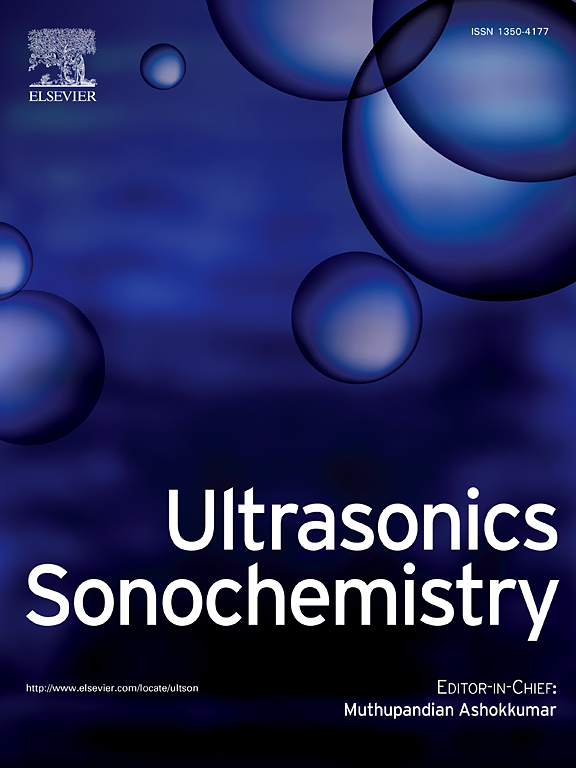超声波辅助下用二元酸性和水合三元深共晶溶剂顺序处理大麦秸秆制备纳米纤维素
IF 9.7
1区 化学
Q1 ACOUSTICS
引用次数: 0
摘要
本研究旨在利用由氯化胆碱和乳酸组成的二元酸性深共熔溶剂(DES)进行生物质预处理,以及由甜菜碱、草酸和水组成的水合三元DES (BOW HDES)进行下游加工以生产纳米纤维素,从而对大麦秸秆进行价值化处理。超声辅助DES预处理显著提高了木质素和半纤维素的增溶性,在最佳条件下,平均木质素去除率为70.54%,半纤维素增溶率为69.58%。对us - des处理的固体残渣进行纯化,纤维素得率为39.81±1.47%,纯度为91.31±0.93%,与常规分馏方法相当或超过常规分馏方法。产率为9.40±0.89%,木质素纯度为83.29±1.57%。此外,纳米纤维素的生产采用一系列工艺,包括低粘度HDES处理,这改善了纤维的膨胀和增溶性,然后是高强度超声(HIUS)处理,用于纳米级除颤。DLS分析表明,77.8%的纳米颗粒直径小于100 nm,表明了纳米材料的高收率。XRD分析证实纤维素I在整个加工过程中保持了结晶结构,保证了结构的完整性。这些发现证明了从农业残留物中提取木质素、纤维素和纳米纤维素的有效和可持续的生物炼制方法,为可扩展的纳米纤维素生产提供了潜力。本文章由计算机程序翻译,如有差异,请以英文原文为准。

Ultrasound-Assisted sequential processing of barley straw using binary acidic and hydrated ternary deep eutectic solvents for nanocellulose production
This study aimed to valorise barley straw by using a binary acidic deep eutectic solvent (DES) made from choline chloride and lactic acid for biomass pretreatment, and a hydrated ternary DES (HDES) composed of betaine, oxalic acid, and water (BOW HDES) for downstream processing to produce nanocellulose. The ultrasound-assisted DES pretreatment significantly enhanced lignin and hemicellulose solubilisation, achieving an average lignin removal of 70.54 % and hemicellulose solubilisation of 69.58 % under optimal conditions. Purification of US-DES-treated solid residue resulted in a cellulose yield of 39.81 ± 1.47 % with a purity of 91.31 ± 0.93 %, comparable to or exceeding conventional fractionation methods. The yield of lignin-rich material was 9.40 ± 0.89 % with a lignin purity of 83.29 ± 1.57 %. Further, nanocellulose was produced using a sequential process comprising low-viscosity HDES treatment, which improved fibre swelling and solubilisation, followed by high-intensity ultrasound (HIUS) treatment for nanoscale defibrillation. DLS analysis of the optimal nanocellulose sample revealed that 77.8 % of nanoparticles had a diameter below 100 nm, demonstrating a high yield of nanoscale material. XRD analysis confirmed the preservation of the cellulose I crystalline structure throughout processing, ensuring structural integrity. These findings demonstrate an efficient and sustainable biorefinery approach for lignin, cellulose, and nanocellulose extraction from agricultural residues, offering potential for scalable nanocellulose production.
求助全文
通过发布文献求助,成功后即可免费获取论文全文。
去求助
来源期刊

Ultrasonics Sonochemistry
化学-化学综合
CiteScore
15.80
自引率
11.90%
发文量
361
审稿时长
59 days
期刊介绍:
Ultrasonics Sonochemistry stands as a premier international journal dedicated to the publication of high-quality research articles primarily focusing on chemical reactions and reactors induced by ultrasonic waves, known as sonochemistry. Beyond chemical reactions, the journal also welcomes contributions related to cavitation-induced events and processing, including sonoluminescence, and the transformation of materials on chemical, physical, and biological levels.
Since its inception in 1994, Ultrasonics Sonochemistry has consistently maintained a top ranking in the "Acoustics" category, reflecting its esteemed reputation in the field. The journal publishes exceptional papers covering various areas of ultrasonics and sonochemistry. Its contributions are highly regarded by both academia and industry stakeholders, demonstrating its relevance and impact in advancing research and innovation.
 求助内容:
求助内容: 应助结果提醒方式:
应助结果提醒方式:


